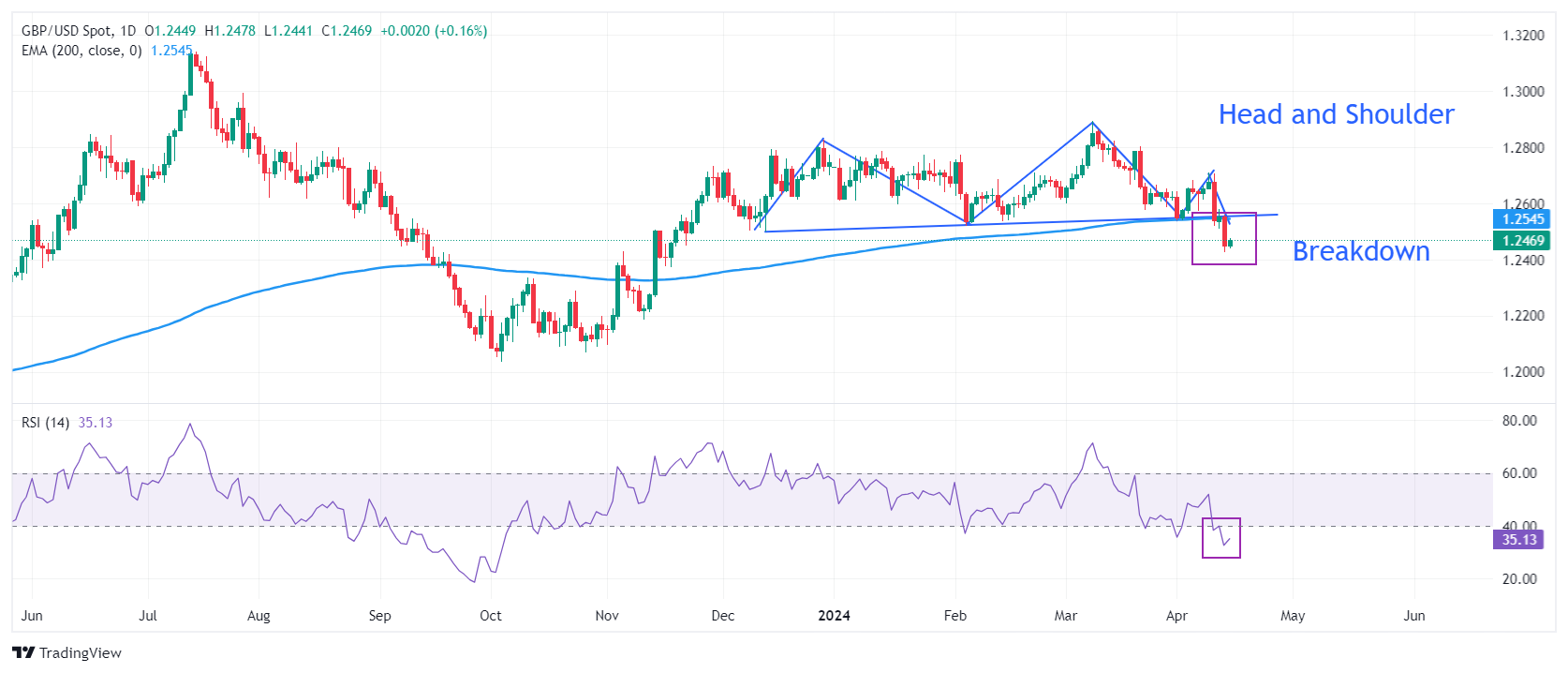- The British pound faces pressure as geopolitical tensions increase the appeal of safe-haven assets.
- UK employment and inflation data will influence speculation on BoE rate cuts.
- The British economy is on its way out of a technical recession.
The British Pound (GBP) shows a modest recovery against the US Dollar in the early hours of the American session. However, short-term demand for GBP/USD remains bearish due to heightened tensions in the Middle East and speculation that the Bank of England (BoE) will begin cutting interest rates ahead of the Federal Reserve. (Fed).
Currently, financial markets anticipate that the BoE will begin to lower borrowing costs from August, while the Fed is expected to do the same from the September meeting.
This week, UK employment and inflation data will once again guide BoE expectations, as markets wonder when its long-awaited rate-cutting cycle might begin. Investors will pay particular attention to February's trailing three-month wage growth data, due out on Tuesday, as it remains a key driver of persistent price pressures in the UK.
Daily Market Summary: Sterling continues to decline, focus on UK jobs
- The British pound finds provisional support after falling to more than four-month lows near 1.2430. The escalation of tensions in the Middle East and the decline in bets that the Federal Reserve (Fed) will lean towards rate cuts at its June meeting have diminished the attractiveness of risk-sensitive currencies.
- Iran's hundreds of airstrikes against Israel in retaliation for its attack on the Iranian embassy in Syria near Damascus, which killed seven members of its Islamic Revolutionary Guard Corps (IRGC), including two generals, have shocked the demand for risk-sensitive currencies.
- Both scenarios – the escalation of geopolitical tensions and the moderation of Fed rate cut hopes – are favorable for the US dollar, considered a safe haven asset. The US Dollar Index (DXY), which measures the price of the Dollar against six major currencies, is approaching its highest level in five months, 106.10 points.
- On the other hand, the good retail sales data for March in the United States reinforces the attractiveness of the US dollar. Retail sales, which represent household spending, grew 0.7%, compared to the 0.3% expected.
- In the UK, improving monthly Gross Domestic Product (GDP) figures have relieved policymakers at the Bank of England (BoE). As expected, monthly GDP for February rose 0.1%, confirming that the economy is on track to emerge from the technical recession recorded in the second half of 2023. The economy also expanded 0.3% in January, revised up from 0.2%.
- With the economic outlook improving, the BoE could maintain tight policy until it gains confidence that inflation will sustainably return to the 2% target.
Technical Analysis: Pound Sterling Struggles to Recover 1.2500

The British Pound experiences a sharp sell-off after breaking the psychological support of 1.2500. The long-term trend of the GBP/USD pair has turned bearish as it has fallen below the 200-day EMA, which is trading around 1.2570.
The breakout of the head and shoulders chart pattern on a daily time frame has indicated a bearish reversal. The neck line of the mentioned chart pattern is drawn from the December 8 low near 1.2500.
The 14-period Relative Strength Index (RSI) falls sharply below 40.00, indicating that fresh bearish momentum has been triggered.
Inflation FAQ
What is Inflation?
Inflation measures the rise in prices of a representative basket of goods and services. General inflation is usually expressed as a month-on-month and year-on-year percentage change. Core inflation excludes more volatile items, such as food and fuel, which can fluctuate due to geopolitical and seasonal factors. Core inflation is the figure economists focus on and is the target level of central banks, which are mandated to keep inflation at a manageable level, typically around 2%.
What is the Consumer Price Index (CPI)?
The Consumer Price Index (CPI) measures the variation in prices of a basket of goods and services over a period of time. It is usually expressed as a percentage of inter-monthly and inter-annual variation. Core CPI is the target of central banks as it excludes food and fuel volatility. When the underlying CPI exceeds 2%, interest rates usually rise, and vice versa when it falls below 2%. Since higher interest rates are positive for a currency, higher inflation usually translates into a stronger currency. The opposite occurs when inflation falls.
What is the impact of inflation on currency exchange?
Although it may seem counterintuitive, high inflation in a country drives up the value of its currency and vice versa in the case of lower inflation. This is because the central bank will typically raise interest rates to combat higher inflation, attracting more global capital inflows from investors looking for a lucrative place to park their money.
How does inflation influence the price of Gold?
Gold was once the go-to asset for investors during times of high inflation because it preserved its value, and while investors often continue to purchase gold for its safe haven properties during times of extreme market turmoil, this is not the case. most of the time. This is because when inflation is high, central banks raise interest rates to combat it.
Higher interest rates are negative for Gold because they increase the opportunity cost of holding Gold versus an interest-bearing asset or placing money in a cash deposit account. On the contrary, lower inflation tends to be positive for Gold, as it reduces interest rates, making the shiny metal a more viable investment alternative.
Source: Fx Street
I am Joshua Winder, a senior-level journalist and editor at World Stock Market. I specialize in covering news related to the stock market and economic trends. With more than 8 years of experience in this field, I have become an expert in financial reporting.







